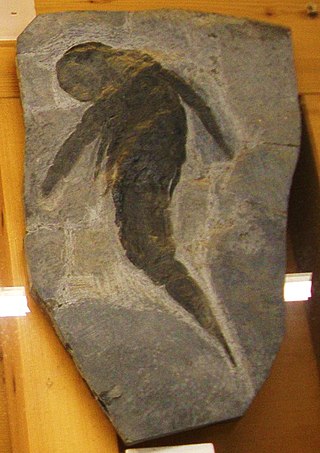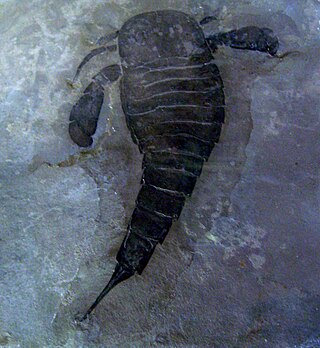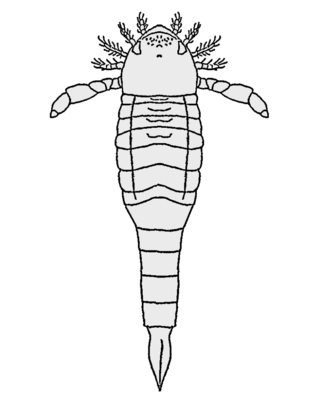
Stylonurina is one of two suborders of eurypterids, a group of extinct arthropods commonly known as "sea scorpions". Members of the suborder are collectively and informally known as "stylonurine eurypterids" or "stylonurines". They are known from deposits primarily in Europe and North America, but also in Siberia.

Dolichopterus is a genus of prehistoric sea scorpions, arthropods in the order Eurypterida. Fossils of Dolichopterus have been discovered in deposits ranging from Silurian to Devonian, and have been referred to several different species, some of them of dubious affinity to this genus.

Mixopterus is a genus of eurypterid, an extinct group of aquatic arthropods. Fossils of Mixopterus have been discovered in deposits from Late Silurian age, and have been referred to several different species. Fossils have been recovered from two continents; Europe and North America.

Chasmataspidids, sometime referred to as chasmataspids, are a group of extinct chelicerate arthropods that form the order Chasmataspidida. Chasmataspidids are probably related to horseshoe crabs (Xiphosura) and/or sea scorpions (Eurypterida), with more recent studies suggest that they form a clade (Dekatriata) with Eurypterida and Arachnida. Chasmataspidids are known sporadically in the fossil record through to the mid-Devonian, with possible evidence suggesting that they were also present during the late Cambrian. Chasmataspidids are most easily recognised by having an opisthosoma divided into a wide forepart (preabdomen) and a narrow hindpart (postabdomen) each comprising 4 and 9 segments respectively. There is some debate about whether they form a natural group.

Brachyopterus is a genus of prehistoric eurypterid of the family Rhenopteridae. It is one of the earliest known eurypterids, having been recovered from Middle Ordovician deposits in Montgomeryshire, Wales. Though other species have been assigned to it in the past, Brachyopterus is today recognized as containing one valid species, B. stubblefieldi.

Drepanopterus is an extinct genus of eurypterid and the only member of the family Drepanopteridae within the Mycteropoidea superfamily. There are currently three species assigned to the genus. The genus has historically included more species, with nine species having been associated with the genus Drepanopterus. Five of these have since been proven to be synonyms of pre-existing species, assigned to their own genera, or found to be based on insubstantial fossil data. The holotype of one species proved to be a lithic clast.

Ctenopterus is a genus of prehistoric eurypterid of the family Stylonuridae. It contains only one species, Ctenopterus cestrotus from the Early Silurian of Otisville, New York.

Parastylonurus is a genus of prehistoric eurypterid. It is classified within the Parastylonuridae family and contains three species, P. hendersoni and P. ornatus from the Silurian of Scotland and P. sigmoidalis from the Silurian of England.

Stylonurella is a genus of prehistoric eurypterid. It is classified within the Parastylonuridae family and contains three species, S. arnoldi and S. beecheri from the Devonian of Pennsylvania, United States and S. spinipes from the Silurian of Kip Burn, Scotland.

Strobilopterus is a genus of prehistoric eurypterid of the family Strobilopteridae. The genus contains four species, two from the Devonian of Wyoming, United States, one from the Devonian of Ohio, United States and one from the Silurian of Estonia.
Tarsopterella is a genus of prehistoric eurypterid classified within the family Hardieopteridae. It contains only one species, T. scotica from the Lower Devonian of Scotland.

Stylonurus is a genus of prehistoric eurypterid of the family Stylonuridae. The genus contains three species: Stylonurus powriensis from the Devonian of Scotland, Stylonurus shaffneri from the Devonian of Pennsylvania and Stylonurus perspicillum from the Devonian of Germany.
Stylonuroides is a genus of prehistoric eurypterid. The genus is classified as a stylonurine but more precise classification has proven difficult, with the genus remaining classified as incertae sedis within the suborder. The genus contains two species, S. dolichopteroides from the Silurian of Ringerike, Norway and S. orientalis from the Devonian of Lake Shunet, Southern Siberia.

Hallipterus is a genus of prehistoric eurypterid classified as part of the family Hardieopteridae.

Parahughmilleria is a genus of eurypterid, an extinct group of aquatic arthropods. Fossils of Parahughmilleria have been discovered in deposits of the Devonian and Silurian age in the United States, Canada, Russia, Germany, Luxembourg and Great Britain, and have been referred to several different species. The first fossils of Parahughmilleria, discovered in the Shawangunk Mountains in 1907, were initially assigned to Eurypterus. It would not be until 54 years later when Parahughmilleria would be described.

The Rhenopteridae are a family of eurypterids, an extinct group of chelicerate arthropods commonly known as "sea scorpions". The family is the only family currently contained in the superfamily Rhenopteroidea, one of four superfamilies classified as part of the suborder Stylonurina.

Eurypteroidea are an extinct superfamily of eurypterids. It contains three families and two genera of uncertain classification, Paraeurypterus and Pentlandopterus.

Waeringopteridae is a family of eurypterids, an extinct group of aquatic arthropods. The Waeringopteridae is the only family classified as part of the superfamily Waeringopteroidea, which in turn is classified within the infraorder Diploperculata in the suborder Eurypterina. The earliest known member of the group, Orcanopterus, has been recovered from deposits of Katian age and the latest known surviving member, Grossopterus, has been recovered from deposits of Siegenian age. The name Waeringopteridae is derived from the type genus Waeringopterus, which is named in honor of eurypterid researcher Erik N. Kjellesvig-Waering.

Brachyopterella is a genus of prehistoric eurypterid classified as part of the Rhenopteridae family. Two species, both from the Silurian period, are known; B. pentagonalis from Norway and B. ritchei from Scotland.

This timeline of eurypterid research is a chronologically ordered list of important fossil discoveries, controversies of interpretation, and taxonomic revisions of eurypterids, a group of extinct aquatic arthropods closely related to modern arachnids and horseshoe crabs that lived during the Paleozoic Era.


















